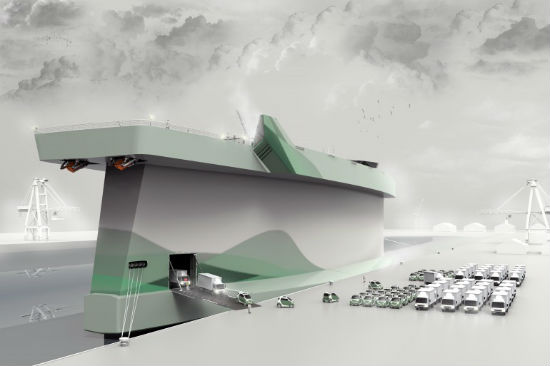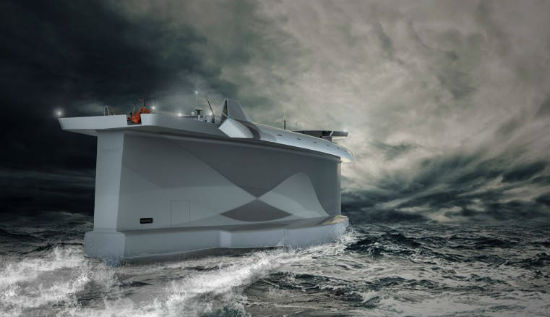Once the Industrial Revolution spurred the move from sailboats to steam-powered and motorized ships, you might have thought that there wasn’t much to improve about such vessels. After all, we now have gigantic cruise ships that feature swimming pools, slides, and a gaggle of Disney characters – what more could we possibly want?
Start thinking green
When it comes to the logistic industry, there are two factors that are always on everyone’s mind – time and money. High fuel prices and bulky designs have traditionally limited the efficiency of even the largest companies’ shipping routes. Furthermore, the recent push toward environmental consciousness has put pressure on carriers to start thinking “green.” Given that the shipping industry accounts for approximately 3% of global CO2 emissions, it’s about time vessel engineers start thinking outside the box. There have been a number of proposed solutions in the past, ranging from wind-powered propellers to sheets of metal sails, but none have gotten very far off the ground.
“Aerodynamics” is the name of the game
Until now. Surprise, surprise – leave it to the Scandinavians to figure out a solution. With a reputation for being particularly progressive and friendly to nature, Norway has come through for us again. LadeAS, a Norwegian ship design company, recently wowed the industry with an inventive new design that completely rethinks the functionality of standard vessels. More specifically, it’s the brainchild of Olso-based speed sailor Terje Lade, who made “aerodynamics” an industry buzzword. The sleek concept ship turns the hull into a sail, thus generating aerodynamic lift and propelling the ship forward with the power of wind. Coupled with a Liquid Natural Gas propulsion system, the vessel would easily be able to gain enough speed to capitalize on the force of steady winds.

Photo Credit: LadeAS
Of course, the design boasts few similarities to the travel methods frequented by such ancient explorers as Christopher Columbus. Unlike these archaic sailboats, Lade’s new design can actually sail into the wind, taking advantage of a similar technology used by airplanes. In this way it is able to “generate pull” from the air, pointing as high as 18 degrees into the wind. Also unlike the wooden vessels of yore, this ship relies heavily on complicated computer systems, which forecast the weather and calculate the best travel route. The algorithms at the base of the system are constantly on high alert, keeping track of weather patterns and directing the crew to speed up, slow down, or change direction.
Early prototypes show exciting potential
Dubbed the “Vindskip,” a fitting name of Icelandic origin that translates to “wind ship,” the design is still solidly in the concept phase. Engineers are using wind tunnels and fluid dynamic computer systems to work out the kinks. A representative for LadeAS revealed that the company could start testing a prototype in a water tank as early as April, with the goal of eventually licensing the design to both shippers and shipyards. Although the company has already garnered two patents for its ingenious design, it will take three or four more years before the vessel is ready for the open seas.
Another indication that the “Vindskip” is primed for success is the attention it has earned from some industry big wigs. For example, one of Norway’s largest ship owners, a company called Wilhelmsen, has already expressed interest in supporting the “futuristic” ambitions of LadeAS. Reports that the ship could reduce fuel costs by 60% and carbon emissions by 80% certainly aren’t reducing the hype.
Price of fuel, sulfur regulations calling the shots
Of course, there will be some logistical obstacles to overcome. For example, several ship builders already have a full schedule of older, less innovative models to build first. Until they manage to clear out this inventory, there might not be as much demand for the Vindskip as some anticipate. The recent decline in oil prices might also cause shipping companies to lose some motivation to invest in alternative designs.

Photo Credit: LadeAS
On the other hand, changes in the regulation of the sulfur content in certain marine fuels are set to significantly increase the expense associated with bunker fuel, an essential element in the distillation process. With the international cap on sulfur content in these fuels expected to fall drastically from 3.5% to 0.5% by 2020, shippers need to come up with a solution, and fast. It’s no easy task to meet these regulations. There’s a good reason behind the change, too – sulfur is incredibly to the marine ecosystem, so a new ship that doesn’t use sulfur at all (aka the Vindskip) might be the miracle cure the shipping industry needs.
Solutions inevitable despite unanswered questions
Even if the wind-assisted models don’t pan out, all hope is not lost. Other big names in shipping – including Maersk – are developing their own, more efficient designs. The good news is that regardless of whether or not we end up with wind-powered ships or not, the right combination of competition and collaboration between engineers, plus a healthy dose of innovation, should ultimately lead the industry to a solution worth the investment.
When is the Vindskip set to be on the seas?
The Vindskip development project is expected to be complete by the end of 2015. FoxNews.com spoke with Lade who says that engineering and construction will take approximately 2 to 3 years. Lade added, “Our estimate is that it should be sailing in 2019.”

